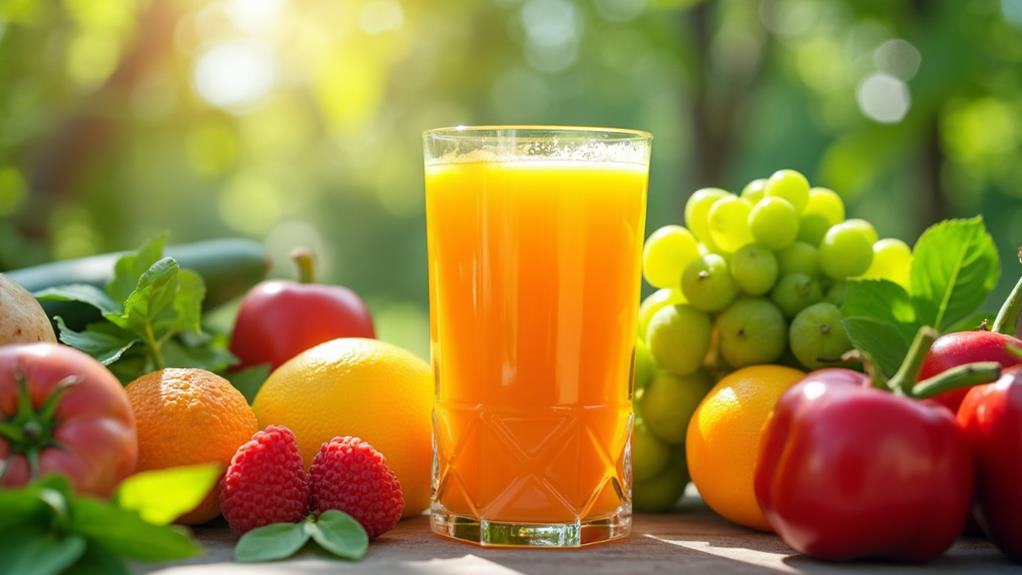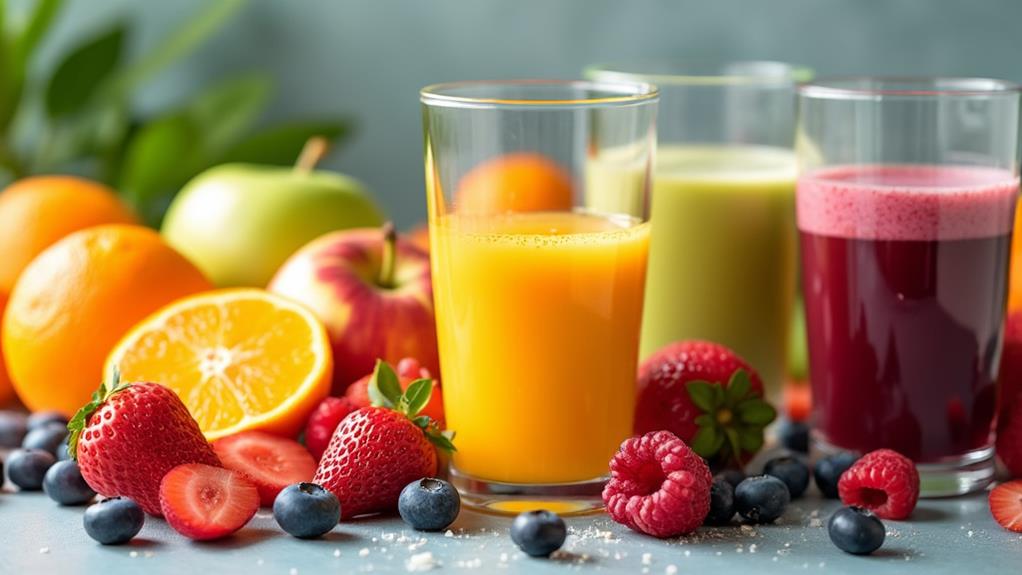Understanding the Environmental Impact of Organic Juice

When you consider your morning glass of organic juice, you might not immediately think about its environmental impact. From carbon emissions during transportation to water usage in irrigation, organic juice production involves several hidden environmental costs. Sustainable practices like local sourcing and efficient irrigation can mitigate some of these impacts, but food waste and packaging emissions also play significant roles. How can consumers and producers make more eco-friendly choices to reduce this footprint? The answers might surprise you and change the way you view your favorite health drink.
Carbon Footprint
When considering the carbon footprint of organic juice, evaluating the entire production process is crucial. Organic juice production involves multiple stages that contribute to its overall environmental impact per glass. For example, producing orange juice can emit approximately 200 grams of CO2 per serving.
The cultivation process significantly impacts the carbon footprint, with growing citrus fruits accounting for 60% of it. Each orange tree requires about 30 gallons of water daily, and the use of gasoline and nitrogen fertilizers further increases greenhouse gas emissions.
Transportation and distribution are also key factors, comprising 22% of total emissions for brands like Tropicana. This underscores the importance of local sourcing to mitigate the carbon footprint of juice production.
Packaging is another critical component, contributing 15% to the beverage's carbon footprint. Traditional materials like PET plastic and paper cartons raise environmental concerns, highlighting the need for sustainable packaging solutions. Choosing juice from concentrate can reduce transportation emissions, as it is lighter due to reduced water content.
Water Management
Considering the substantial carbon footprint in organic juice production, addressing water management practices is equally fundamental. Efficient irrigation techniques are vital for the optimal growth of citrus trees. The University of Arizona emphasizes these practices, which can significantly reduce water waste and enhance productivity. For instance, an average orange tree requires about 30 gallons of water daily, underscoring the need for sustainable water management in organic farming to maintain high fruit yield and quality.
Water scarcity can severely impact fruit yield and juice quality, making sustainable water use essential. Implementing effective water management practices can mitigate environmental impacts and support the long-term viability of organic farming. Local sourcing of fruit also plays a crucial role by reducing transportation emissions and utilizing regional water resources more efficiently.
Incorporating sustainable water management practices ensures the production of high-quality organic juice while protecting the environment. This approach helps balance consumer demand with the conservation of vital water resources. By focusing on sustainable water use, you contribute to a more resilient and environmentally friendly organic juice industry.
Sustainable Practices
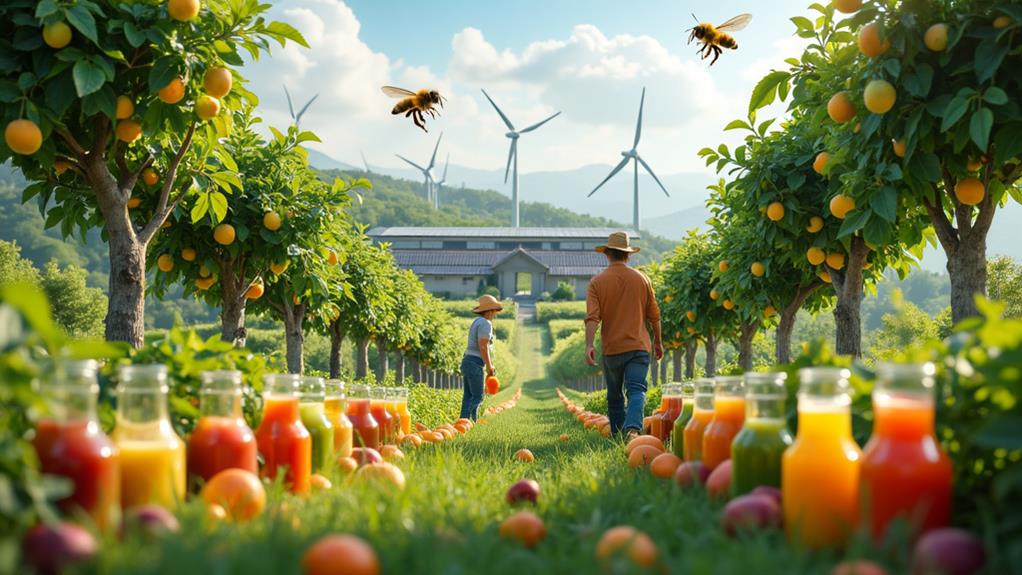
Sustainable practices in organic juice production are essential for reducing environmental impact while catering to consumer demand. Implementing efficient irrigation techniques is crucial for minimizing water waste. For instance, an average orange tree requires 30 gallons of water daily, so effective water management is key to boosting productivity.
Local sourcing of organic fruits is another critical aspect. This not only supports eco-friendly farming but also significantly reduces transportation emissions. Additionally, opting for juice from concentrate can further decrease the carbon footprint, as it involves less water content during transport.
Incorporating circular economy principles helps minimize waste. Over half of the raw materials in juice production become byproducts, leading to up to 20 million tons of waste annually. By focusing on reusing these byproducts, the industry can become more sustainable.
Lastly, the choice of packaging has a considerable impact. Selecting glass packaging over plastic reduces waste and promotes recycling efforts. Here are three key sustainable practices to prioritize:
- Efficient irrigation techniques
- Local sourcing of organic fruits
- Glass packaging for recycling
Food Waste
When producing organic orange juice, over half of the raw materials become waste, generating up to 20 million tons annually. This waste, primarily thick peels and pulp, usually ends up in landfills, releasing methane, a potent greenhouse gas. By repurposing these byproducts and implementing circular economy strategies, it is possible to significantly reduce food waste and its environmental impact.
Repurposing Orange Juice Byproducts
The orange juice industry faces a substantial challenge with the vast amount of byproducts generated, where more than half of the raw materials become waste. This results in up to 20 million tons of waste annually. However, repurposing these byproducts can significantly reduce environmental impact and support a circular economy. Here are three effective methods to repurpose orange juice byproducts:
- Animal Feed: Orange peels and pulp can be converted into nutritious animal feed, reducing the need for conventional feed and lowering agricultural waste.
- Biofuel: Transforming organic waste into biofuel provides a sustainable energy source, reducing reliance on fossil fuels and lowering greenhouse gas emissions.
- Natural Flavorings: Extracting essential oils and natural flavorings from orange peels minimizes waste and creates valuable products for the food and beverage industry.
Addressing food waste through these methods not only mitigates waste but also creates economic opportunities. Implementing circular economy principles enhances waste recovery efforts and improves resource efficiency, making juice production more sustainable and environmentally friendly.
Methane Emissions From Landfills
Addressing the environmental consequences of food waste ending up in landfills is crucial. When food waste, including citrus fruits like oranges, decomposes in landfills, it produces methane emissions. Methane is a potent greenhouse gas, with 80 times the warming potential of CO2 over a 20-year period. This makes managing food waste fundamental for mitigating climate change.
The orange juice industry is particularly problematic in this context. Over half of the raw materials become byproducts, and the industry generates up to 20 million tons of waste annually. Much of this waste, including thick peels and pulp, ends up in landfills, contributing significantly to methane emissions.
Addressing food waste is not just about reducing greenhouse gases; it's also about improving resource efficiency. By keeping orange juice byproducts out of landfills, methane emissions can be minimized, and resources can be utilized more effectively. Implementing principles of a circular economy is critical in this effort. For example, repurposing orange waste as raw material for new products can drastically reduce the environmental footprint of juice production.
Circular Economy Strategies
Implementing circular economy strategies in the organic juice industry can significantly reduce environmental impact by addressing food waste. The industry generates up to 20 million tons of waste annually, with over half of the raw materials used in orange juice production becoming byproducts. By focusing on waste recovery, citrus waste such as peels and pulp can be repurposed into new products, thereby reducing food waste and minimizing the environmental footprint of juice production.
Key Strategies:
- Waste Recovery: Convert thick peels and pulp into valuable products like bioenergy or animal feed, thereby reducing the amount of waste sent to landfills.
- Collaboration: Partner with other industries to enhance waste recovery efforts, fostering a circular economy that promotes resource efficiency.
- Sustainable Product Development: Innovate new, sustainable products from citrus byproducts, facilitating creative environmental solutions.
Food waste in landfills generates methane, a potent greenhouse gas. Addressing waste in the organic juice sector is crucial for mitigating its contribution to climate change. By adopting circular economy principles, the industry can not only reduce waste but also create opportunities for sustainable product development. These strategies can significantly improve environmental outcomes and help combat climate change by reducing the industry's overall environmental footprint.
Circular Economy
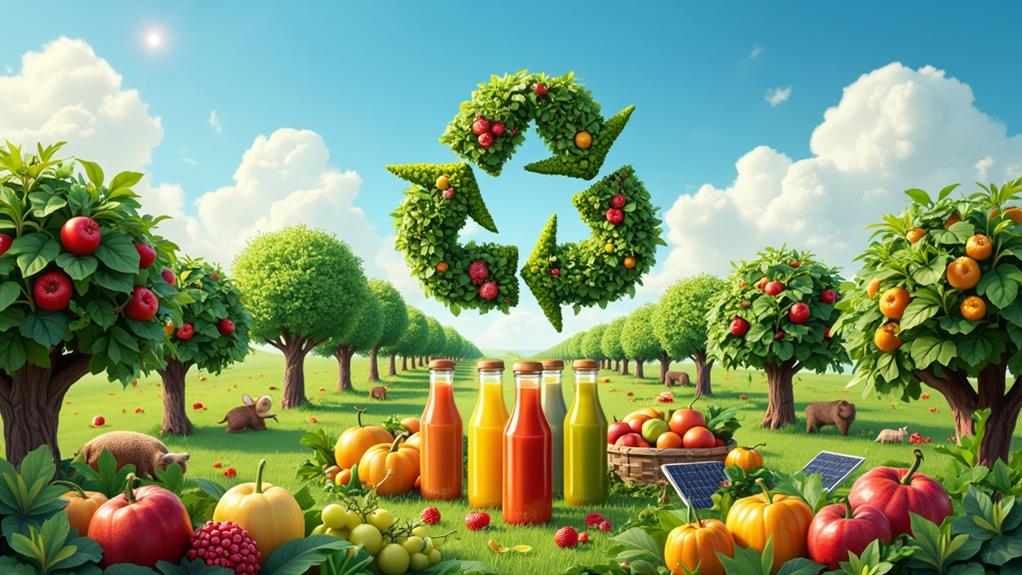
The circular economy offers a sustainable framework for the fruit juice industry, effectively addressing its significant waste generation challenges. By repurposing citrus waste such as peels and pulp into new products, the environmental footprint of juice production can be significantly reduced. This practice not only minimizes landfill usage but also curtails greenhouse gas emissions from decomposing organic waste.
However, implementing circular economy principles extends beyond waste recovery. It involves adopting sustainable practices across the entire juice production process. For example, local sourcing of fruits helps reduce transportation emissions, aligning operations with circular economy goals. Additionally, using juice concentrates can further decrease transportation-related emissions, promoting a more sustainable product lifecycle.
Collaboration across industries is essential to enhance these efforts. By working together, industries can improve resource efficiency and reduce food waste on a larger scale. Below is a summary of how circular economy principles can reshape juice production:
| Circular Economy Principle | Impact on Juice Production |
|---|---|
| Waste Recovery | Repurposes citrus waste, reduces landfill use |
| Sustainable Practices | Local sourcing cuts transportation emissions |
| Resource Efficiency | Minimizes raw material waste |
| Emission Reduction | Lowers greenhouse gas emissions |
| Industry Collaboration | Improves overall sustainability |
Packaging Emissions
Packaging emissions significantly contribute to the overall environmental impact of organic juice, accounting for approximately 15% of the beverage's total carbon footprint. Consumer use and disposal add another 3%. Choosing the right packaging can substantially mitigate these emissions. For example, Tetra Pak cartons are considered a more responsible choice, though their effectiveness is hindered by limited recycling facilities. Nevertheless, recycling rates for Tetra Pak have improved from 6% to 18% between 2009 and 2018, indicating progress.
Here are three key points to consider:
- Material Choice: The carbon footprint of fruit juice packaging varies significantly depending on the raw material used. Glass packaging, for instance, can help reduce plastic waste and enhance recycling efforts.
- Recycling Rates: While Tetra Pak's recycling rates have increased, the lack of widespread recycling facilities limits its eco-friendliness.
- Water Use: The carbon footprint is also influenced by the distance the fruit is transported and the climate in which it is grown. Fruits from drier climates require more water, thus increasing the total carbon footprint.
Transportation Emissions

Transportation emissions significantly contribute to the environmental impact of organic juice, accounting for around 22% of its carbon footprint. The distance juice travels from the orchard to your table directly affects the greenhouse gas emissions produced. Longer transportation routes mean more fuel consumption, increasing the overall environmental impact.
To reduce the carbon footprint of your juice, consider opting for locally sourced options. These juices travel shorter distances, thereby generating fewer transportation emissions. This choice not only benefits the environment but also supports local economies.
Additionally, consider whether the juice is from concentrate. From-concentrate juices contain less water, making them lighter and easier to transport, which reduces transportation emissions. In contrast, not-from-concentrate juices are heavier and require more resources for distribution.
Packaging also plays a role. Juice packaged in PET plastic or cartons adds to transportation emissions due to their weight and volume. Choosing more environmentally friendly packaging can further reduce the carbon footprint of your juice. Each small decision you make contributes to a greener planet.
Corporate Sustainability
Opting for locally sourced organic juice can significantly reduce transportation emissions, but the responsibility extends beyond consumers. Corporations are crucial in promoting sustainability by minimizing their carbon footprint and practicing environmental responsibility. For example, PepsiCo's collaboration with Carbon Trust to certify the carbon footprint of its Tropicana brand is a positive step.
Corporate sustainability efforts typically include:
- Transparency: Companies like M&S and PepsiCo openly report their carbon emissions and set annual reduction targets of 2.5% or more. This transparency fosters accountability and motivates other businesses to follow suit.
- Local Sourcing: Since transportation accounts for around 22% of Tropicana's total carbon footprint, sourcing ingredients locally can significantly reduce emissions and support local economies.
- Investment in Green Technologies: Investing in sustainable technologies improves resource efficiency, cuts long-term costs, and enhances brand image. It also builds consumer trust, as people prefer brands that prioritize the planet.
Adopting these practices demonstrates a commitment to environmental responsibility and helps make food production more sustainable. Supporting such companies can drive further positive change.
Consumer Choices
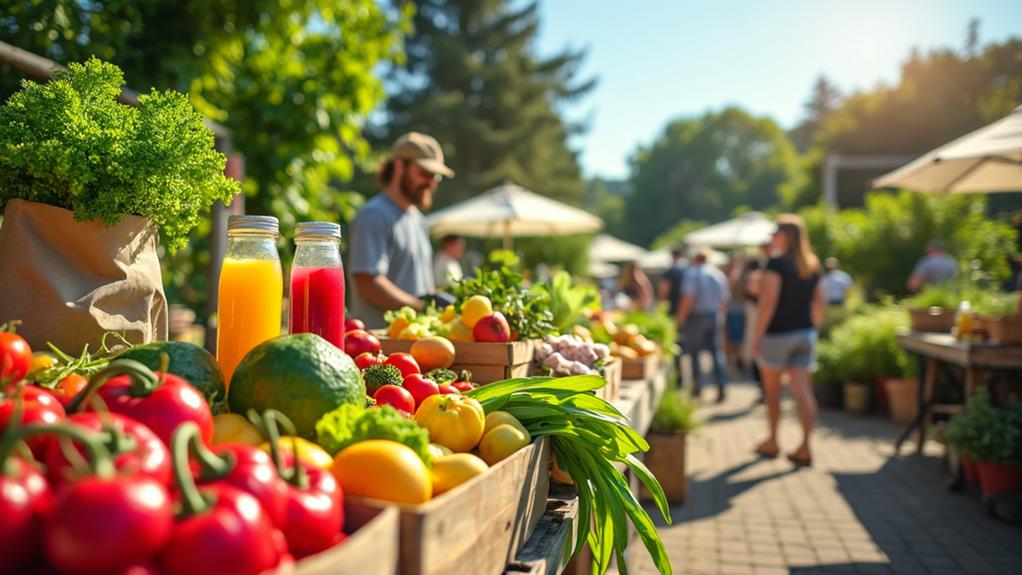
When choosing organic juice, you can make a significant impact by prioritizing ethical purchasing and local sourcing. Opting for Fairtrade brands ensures that farmers are fairly compensated, and locally sourced options reduce transportation emissions. Additionally, making homemade organic juice from local produce minimizes packaging waste and food miles, supporting a more sustainable lifestyle.
Ethical Juice Purchasing Tips
Navigating the world of juice purchases can be daunting, but making ethical choices is achievable. By focusing on Fairtrade, organic, and sustainable options, you can positively impact the environment with your juice purchases.
- Choose Fairtrade Juices: Select juices with the Fairtrade label to ensure fair treatment and ethical labor practices for workers. This supports the well-being of farmers and workers in the juice production industry.
- Opt for Organic Juices: Organic juices are free from pesticide residues and support sustainable farming practices. Choosing organic promotes environmental health and reduces your exposure to harmful chemicals.
- Consider Packaging: The type of packaging your juice comes in significantly affects its environmental footprint. Prefer juices packaged in glass containers over plastic to reduce waste and support recycling efforts, as glass is more easily recyclable.
Additionally, look for brands with transparent sustainability practices, such as those certified by the Carbon Trust, to ensure informed decisions. By considering these factors, you're not just buying juice—you're contributing to a more sustainable and ethical world.
Local Sourcing Benefits
Local sourcing of fruit for juice production offers numerous environmental and economic benefits. By choosing locally made organic juices, you can significantly reduce transportation emissions, thereby lowering the total carbon footprint of your juice consumption. Opting for seasonal fruits grown nearby also minimizes the need for energy-intensive cold storage and long-distance shipping, both of which contribute to a higher carbon footprint.
| Benefit | Explanation |
|---|---|
| Reduced Emissions | Less transportation lowers the carbon footprint. |
| Support for Local Economy | Buying local enhances regional economic stability. |
| Less Packaging Waste | Minimal packaging aligns with eco-friendly practices. |
For example, Tropicana has indicated that distribution alone accounts for 22% of their total emissions. By sourcing fruits locally, you reduce these transportation emissions. Additionally, homemade juice using local produce can significantly reduce food miles, further contributing to eco-friendly practices.
Supporting local sourcing not only helps the environment but also benefits your community. You promote sustainability while enjoying the freshest, most nutritious juice possible. So, the next time you're at the store, think about where your juice comes from and consider the positive impact of choosing local, seasonal fruits. This is a simple yet impactful way to practice eco-friendly habits and reduce your carbon footprint.

